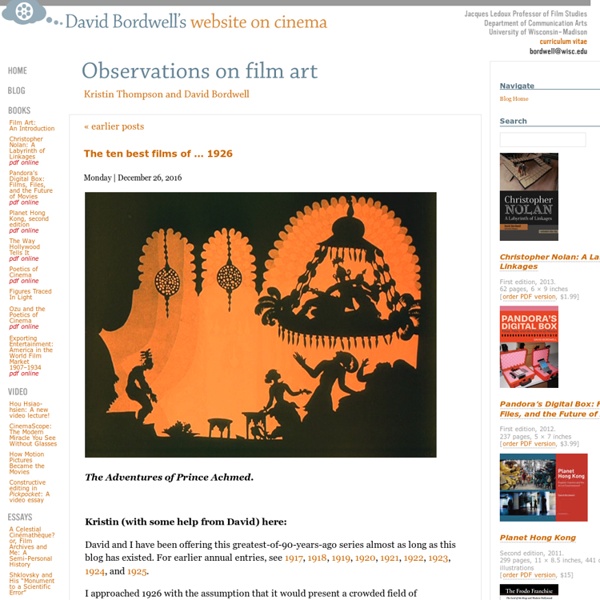girish
| The Permanent Seminar on Histories of Film Theories |
Film criticism: Always declining, never quite falling
Daumier, Le mélodrame (1860-64) DB here: Before the Internets, did people fret as much about movie criticism as they do now? The dialogue has become as predictable as a minuet at Versailles. Film criticism is dead. No, it’s not! Hah! Well, the track record of the official movie critics isn’t that great. Infinitely more awful is what you read on the Net. The result being….? Same thing goes for the Net. Yeah? But not a passion for using Spellcheck. So if print criticism is so valuable, how come all those professional critics are getting fired? Film criticism is dead. Repeat as often as you like. I thought I had watched this rondelay often enough from the wallflower section, but I got dragged onto the dance floor by Tom Doherty. To watch their backs and retain their 401(k)’s, most print critics have been forced into sleeping with the enemy. Feeling the same heat, academic critics have also plunged into the brash new world. Unhappily, none of this enhanced our 401(k)s. Nothing if not critical
Sergio Leone and the Infield Fly Rule
Film Studies For Free
In Conversation: Steven Soderbergh
Steven Soderbergh has directed 26 films since his 1989 debut, sex, lies, and videotape — the behind-closed-doors portrait of yuppie Louisiana often credited with kick-starting the indie-film revolution of the nineties, released when he was only 26. In the 24 years since, he’s been a remarkably prolific chameleon, managing arguably more than any other director of his generation to successfully bounce between the low- and high-budget, not only directing but often editing and shooting his own films, each, in its way, an audacious experiment. In one extraordinary three-year streak — 1998 to 2001 — he directed two noirish classics (Out of Sight, The Limey), pulled an Oscar performance out of Julia Roberts (Erin Brockovich), earned an Oscar of his own (Traffic, the same year he was also nominated for Brockovich), and launched a lucrative franchise (Ocean’s Eleven, followed by Twelve and Thirteen). So, retirement.Just to be clear, I won’t be directing “cinema,” for lack of a better word.
davekehr.com
Screenplay Basics - Scripped - StumbleUpon
A Scripped Compendium by Johnathan Carr Traditional storytelling recounts past events, whereas screenwriting is locked in the present - thus you may not deviate from PRESENT TENSE. You may also be tempted to describe every inch of the world you're creating - don't! Take comfort in the idea that a screenplay is not meant to have any literary value. As you're writing, be mindful to preserve only the most important details: information that will advance the story. At the beginning of a feature film script, often but not always, the first line will be: FADE IN. While you can write a longer ACTION paragraph, think about keeping it under five lines at a time. In the ACTION line, be sure to capitalize SOUND EFFECTS, CAMERA DIRECTION and the first appearance of a speaking CHARACTER. Use a PARENTHETICAL to note an action the speaker is performing while speaking or if you want to indicate whom the speaker is addressing such as addressing a new character in mid-DIALOGUE. Think subtext.
The Mad Men Account by Daniel Mendelsohn
Mad Men a television series created by Matthew Weiner Lionsgate, 4 DVDs per season: Seasons 1 and 2, $39.98 each; Season 3, $49.98; Season 4 (to be released March 29, 2011), $49.98 Since the summer of 2007, when Mad Men premiered on the cable station AMC, the world it purports to depict—a lushly reimagined Madison Avenue in the 1960s, where sleekly suited, chain-smoking, hard-drinking advertising executives dream up ingeniously intuitive campaigns for cigarettes and bras and airlines while effortlessly bedding beautiful young women or whisking their Grace Kelly–lookalike wives off to business trips in Rome—has itself become the object of a kind of madness. At first glance, this appeal seems to have a lot to do with the show’s much-discussed visual style—the crisp midcentury coolness of dress and decor. With these standouts (and there are many more), Mad Men shares virtually no significant qualities except its design.
Featured Texts




Le blog des critiques Kristin Thompson et David Bordwell est dédié au cinéma et à ses éléments tertiaires. On y retrouve des suggestions de lecture, des expositions ayant pour thème le cinéma, des critiques (bien sûr!) et des vidéos éducatifs. Ces derniers sont particulièrement riches en informations pouvant être utiles à des étudiants du cégep ou de l'université. by hubertouellet Feb 16